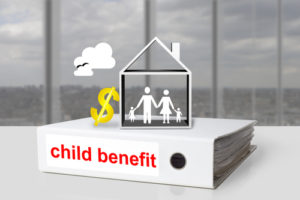 By Aaron Hector, Doherty & Bryant Financial Strategists Inc.
By Aaron Hector, Doherty & Bryant Financial Strategists Inc.
Special to the Financial Independence Hub
Budget 2016 introduced a new child benefit program called the Canada Child Benefit (CCB). This program replaced the UCCB, and despite their similar acronyms, they are very different from one another.
The U in UCCB stood for universal, and it was just that. Every Canadian resident family with a child under 18 received a benefit. For children aged 0-5, the amount was $160/month and for children aged 6-17 the amount was $60/month. This benefit was taxable as income to the lower income earning spouse (or single caregiving parent).
In contrast, CCB payments are tax-free. Eligibility for CCB payments are based on your family’s combined net income. The word “net” is important as it leads into other tax planning ideas that we will explore a little later on. In general terms, when compared with the UCCB the new program provides a higher benefit for lower and middle-income families at the expense of reduced benefits for high-income families. The specific calculation is as follows:
Step 1 – Calculate the maximum benefit
1. For each child aged 0-5 there is a maximum benefit of $6,400
2. For each child aged 6-17 there is a maximum benefit of $5,400
Step 2 – Calculate your family net income
1. This is the combined net income of both parents in the household or that of a single parent.
2. Your net income can be found on line 236 of your income tax return. Your net income will be your total income from all sources less deductions, the most common of which would be a deduction for your RRSP or pension plan contributions.
Step 3 – Calculate your benefit clawback
1. There is no clawback on family net income below $30,000
2. On family net income between $30,000 and $65,000, there will be a clawback that is based on the number of children in your family. The clawback is:
a. 1 child = 7%
b. 2 children = 13.5%
c. 3 children = 19%
d. 4 or more children = 23%
3. In addition to what’s calculated above, for a family with a net income over $65,000 the clawback on the excess would be:
a. 1 child = $2,450 + 3.2%
b. 2 children = $4,725 + 5.7%
c. 3 children = $6,650 + 8%
d. 4 or more children = $8,050 + 9.5%
For example, a family with 3 children ages 2, 4, and 6 with less than $30,000 of income would qualify for the maximum benefit of $18,200 ($6,400, $6,400, and $5,400). If this same family had a net income of $64,000, then they would be subject to a 19% clawback on the $34,000 of income that was in excess of $30,000 ($34,000 x 19% = $6,460), and they would be left with $11,740. If their family net income was $125,000 they would be subject to a 19% clawback on $35,000 of income between $30,000 and $65,000, and 8% clawback on the $60,000 in excess of $65,000. This family would be left with CCB benefits of $6,750.
Now that we understand what the CCB is and how it is calculated, we can start to actually do some planning around how to maximize the benefit.
Key Planning Point 1 – You have a new marginal tax rate.
Your marginal tax rate is the rate of tax that you pay on your next dollar of income. For example, let’s look at a family where there is one stay at home parent with zero income, and the other parent earns a gross income of $64,000. In most provinces, that would equate to a marginal tax rate of approximately 30%. However, the next dollar of income this person earns will also be subject to a 19% clawback of their CCB benefits. Effectively, this person has a tax rate of 49%!
At this level, income reduction strategies are very important and the use of a non-registered investment account when there is available room to contribute to a TFSA or RRSP would be ill-advised. When TFSA and RRSP accounts are maxed out, consideration should be given to holding income-producing assets inside tax sheltered accounts, and long-term capital gain (buy and hold) investments inside non-registered accounts.
Key Planning Point 2 – RRSP contributions are more important than ever
Given that you could now see a middle-income family with a very high effective marginal tax rate, RRSP contributions make more sense than ever. For every dollar that is saved inside your RRSP, you could recoup one half via tax savings and increased CCB benefits. The full amount of the contribution can grow inside the RRSP on a tax-deferred basis until an eventual withdrawal at some point later in life.
Key Planning Point 3 – You may never have a better reason to adjust your prior year tax returns
If you made RRSP contributions in any of the past 2 or 3 tax years (2012 – 2014), you could consider adjusting those tax returns to remove your RRSP deduction. Remember, just because you make an RRSP contribution in a given year does not mean that you are required to claim the deduction in that year. You can instead choose to carry it forward into the future.
The rationale here is to remove deductions from UCCB tax years and then apply them as a lump sum onto your 2015 tax return to lower your 2015 net income (which will be the basis for calculating the first benefit period for the CCB). Care and attention need to be taken here as this will result in an increased tax bill (along with interest charges) in those prior tax years, but in the right circumstance you could very well be much further ahead. I would suggest contacting your accountant or financial planner before taking this approach.
Key Planning Point 4 – Next Generation Wealth Transfer
I will often have meetings with parents (or grandparents) who are looking for ways to help out their children financially. It is important to note that gifts from parents to children are not taxable in Canada, and so long as the child has attained the age of majority there will be no tax attribution consequences.
The discussion will sometimes lead into overall family tax planning and the parents may choose to gift annual amounts to their children so that they can top up their TFSA accounts. It isn’t uncommon for grandparents to gift money to be used for RESP contributions to take advantage of government grants and tax-deferred growth. In my experience, it has been less common for parents to gift so that their children can make RRSP contributions, but with the changing CCB rules this could at least be brought up in future discussions as this gift would not only provide long-term financial assistance to the next generation via the RRSP, but it would also provide a short-term cash flow benefit via an enhanced CCB.
 Aaron Hector has been a consultant at Doherty & Bryant Financial Strategists, a subsidiary of T.E. Wealth, for nearly 10 years. He provides comprehensive financial planning to high-net-worth individuals and families in Western Canada, and has extensive experience in executive compensation plans, retirement planning, and income tax reduction strategies. As a dual citizen of Canada and the USA, he also has a passion for cross-border financial planning.
Aaron Hector has been a consultant at Doherty & Bryant Financial Strategists, a subsidiary of T.E. Wealth, for nearly 10 years. He provides comprehensive financial planning to high-net-worth individuals and families in Western Canada, and has extensive experience in executive compensation plans, retirement planning, and income tax reduction strategies. As a dual citizen of Canada and the USA, he also has a passion for cross-border financial planning.

